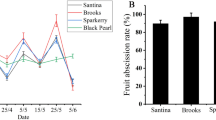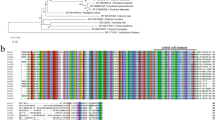Abstract
A new full-length cDNA encoding strictosidine synthase (designated as OjSTR, GenBank Accession No. 1087598), which catalyzes a committed step in camptothecin biosynthetic pathway, was isolated from young leaves of Ophiorrhiza japonica for the first time. OjSTR was 1,258 bp and contained a 1,062 bp open reading frame encoding a deduced protein of 353 amino acid residues. Sequence analyses showed that OjSTR had high homology with other STRs from some TIA-producing plants. Phylogenetic tree analysis showed that OjSTR had closest relationship with STR from O. pumila. Tissue expression pattern analysis revealed that OjSTR constitutively expressed in all the tested tissues at different levels, which was high in flower, moderate in leaf and root, low in stem. Expression profiles under plant defense signals such as methyl jasmonate and salicylic acid were investigated, and the results revealed that expression of OjSTR was all induced, implying that OjSTR was high elicitor responsive.







Similar content being viewed by others
Abbreviations
- CPT:
-
Camptothecin
- MeJA:
-
Methyl jasmonate
- ORF:
-
Open reading frame
- RACE:
-
Rapid amplification of cDNA ends
- SA:
-
Salicylic acid
- STR:
-
Strictosidine synthase
- TIAs:
-
Terpenoid indole alkaloids
References
Wall ME, Wani MC, Cook CE, Palmer KH (1966) Plant anti-tumor agents I. The isolation and structure of camptothecin-a novel alkaloidal leukemia and tumor inhibitor from Camptotheca acuminata. J Am Chem Soc 88:3888–3890
Lorence L, Nessler CL (2004) Camptothecin, over four decades of surprising findings. Phytochemistry 65:2735–2749. doi:10.1016/j.phytochem.2004.09.001
Gunasekera SP, Badawi MM, Cordell GA, Farnsworth NR, Chitnis M (1979) Plant anticancer agents X. Isolation of camptothecin and 9-methoxycamptothecin from Ervatamia heyneana. J Nat Prod 42:475–477. doi:10.1021/np50005a006
Arisawa M, Gunasekera SP, Cordell GA, Farnsworth NR (1981) Plant anticancer agents XXI Constituents of Merrilliodendron megacarpum. Planta Med 43:404–407. doi:10.1055/s-2007-971533
Govindachari TR, Viswanathan N (1972) Alkaloids of Mappia foetida. Phytochemistry 11:3529–3531
Tafur S, Nelson JD, De Long DC, Svoboda GH (1976) Antiviral components of Ophiorrhiza mungos. Isolation of camptothecin and 10-methoxycamptothecin. Lloydia 39:261–262
Aimi N, Nishimura M, Miwa A, Hoshino H, Sakai S, Haginiwa (1989) Pumiloside and deoxypumiloside plausible intermediates of camptothecin biosynthesis. Tetrahedron Lett 30:4991–4994
Wang JC (1985) DNA topoisomerases. Annu Rev Biochem 54:665–697. doi:10.1146/annurev.bi.54.070185.003313
Kjeldsen E, Svejstrup JQ, Gromova II, Alsner J, Westergaard O (1992) Camptothecin inhibits both the cleavage and relegation reactions of eukaryotic DNA topoisomerase I. J Mol Biol 28:1025–1030. doi:10.1016/0022-2836(92)90310-G
Oberlies NH, Kroll DJ (2004) Camptothecin and taxol: historic achievements in natural products research. J Nat Prod 67:129–135. doi:10.1021/np030498t
Rothenberg ML (1997) Topoisomerase I inhibitors: review and update. Ann Oncol 8:837–855. doi:10.1023/A:1008270717294
Wall ME (1998) Camptothecin and taxol: discovery to clinic. Med Res Rev 18:299–314. doi:10.1002/(SICI)1098-1128(199809)18:5<299:AID-MED2>3.0.CO;2-O
Priel E, Showalter SD, Blair DG (1991) Inhibition of human immunodeficiency virus (HIV-1) replication in vitro by non-cytotoxic doses of camptothecin, a topoisomerase I inhibitor. AIDS Res Hum Retroviruses 7:65–72
Li S, Adair KT (1994) Camptotheca acuminata Decaisne XI SHU (Chinese Happy tree) a promising anti-tumor and anti-viral tree for the 21st century. Tucker Center, College of Forestry, Stephen F. Austin State University Press, Nacogdoches
Lorence L, Nessler CL (2004) Camptothecin, over four decades of surprising findings. Phytochemistry 65:2735–2749. doi:10.1016/j.phytochem.2004.09.001
Springob K, Saito K (2002) Metabolic engineering of plant secondary metabolism: a promising approach to the production of pharmaceuticals. Sci Cult 68:76–85
Hutchinson CR, Heckendorf AH, Straughn JL, Daddona PE, Cane DE (1979)) Biosynthesis of camptothecin. 3. Definition of strictosamide as the penultimate biosynthetic precursor assisted by 13C and 2H NMR spectroscopy. J Am Chem Soc 101:3358–3369. doi:10.1021/ja00506a037
Kutchan TM, Bock A, Dittrich H (1994) Heterologous expression of the plant proteins strictosidine synthase and berberine bridge enzyme in insect cell culture. Phytochemistry 35:353–360. doi:10.1016/S0031-9422(00)94763-0
Kutchan TM (1989) Expression of enzymatically active cloned strictosidine synthase from the higher plant Rauvolfia serpentina in Escherichia coli. FEBS Lett 257:127–130. doi:10.1016/0014-5793(89)81802-2
McKnight TD, Roessner CA, Devagupta R, Scott AI, Nessler CL (1990) Nucleotide sequence of a cDNA encoding the vacuolar protein strictosidine synthase from Catharanthus roseus. Nucleic Acids Res 18:4939. doi:10.1093/nar/18.16.4939
Canel C, Lopes-Cardoso MI, Whitmer S (1998) Effects of over-expression of strictosidine synthase and tryptophan decarboxylase on alkaloid production by cell cultures of Catharanthus roseus. Planta 205:414–419. doi:10.1007/s004250050338
Kai GY, Dai LM, Mei XY, Zheng JG, Wang W, Lu Y et al (2008) In vitro plant regeneration from leaf explants of Ophiorrhiza japonica. Biol Plant 52(3):557–560
Yi BL, Peng QZ, Tian XR (2007) The research of camptothecin content in two Ophiorrhiza in XiangXi. J Changsha Univ 21(5):35–36
Kai GY, Miao ZQ, Zhang L, Zhao DL, Liao ZH, Sun XF et al (2006) Molecular cloning and expression analyses of a new gene encoding 3-hydroxy-3- methylglutaryl-CoA synthase from Taxus x media. Biol Plant 50:359–366. doi:10.1007/s10535-006-0050-0
Kai GY, Zhao LX, Zhang L, Li ZG, Guo BH, Zhao DL et al (2005) Characterization and expression profile analysis of a new cDNA encoding taxadiene synthase from Taxus media. J Biochem Mol Biol 38:675–685
Thompson JD, Gibson TJ, Plewniak F, Jeanmougin F, Higgins DG (1997) The CLUSTAL X windows interface:flexible strategies for multiple sequence alignment aided by quality analysis tools. Nucleic Acids Res 25:4876–4882. doi:10.1093/nar/25.24.4876
Kumar S, Tamura K, Jakobsen IB, Nei M (2001) MEGA2: molecular evolutionary genetics analysis software. Bioinformatics 12:1244–1245. doi:10.1093/bioinformatics/17.12.1244
Yamazaki Y, Sudo H, Yamazaki M, Aimi N, Saito K (2003) Camptothecin biosynthetic genes in hairy roots of Ophiorrhiza pumila: cloning, characterization and differential expression in tissues and by stress compounds. Plant Cell Physiol 44(4):395–403. doi:10.1093/pcp/pcg051
Pasquali G, Goddijn OJ, de Waal A, Verpoorte R, Schilperoort RA, Hoge JH et al (1992) Coordinated regulation of two indole alkaloid biosynthetic genes from Catharanthus roseus by auxin and elicitors. Plant Mol Biol 18(6):1121–1131. doi:10.1007/BF00047715
Wang H, Shen R, Chen M, Sun M, Liao ZH (2006) Molecular cloning and characterization of a new cDNA encoding strictosidine synthase from Rauvolfia verticillata. Acta Bo Boreal-Ocident Sin 26(5):900–905
Geourjon C, Deléage G (1995) SOPMA: significant improvement in protein secondary structure prediction by consensus prediction from multiple alignments. Cabios 11:681–684
Ma X, Panjikar S, Koepke J, Lorisand E, Sto¨ckigt J (2006) The Structure of Rauvolfia serpentina strictosidine synthase is a novel six-bladed b-propeller fold in plant proteins. Plant Cell 18:907–920. doi:10.1105/tpc.105.038018
Kai GY, Jiang JH, Zhao DL, Zhao LX, Zhang L, Li ZG et al (2006) Isolation and expression profile analysis of a new cDNA encoding 5-alpha-taxadienol-10-beta-hydroxylase from Taxus media. J Plant Biochem Biotechnol 15:1–5
Jordan MA, Thrower D, Wilsen L (1991) Mechanism of inhibitionof cell proliferation by vinca alkaloids. Cancer Res 51:2212–2222
Yamazaki Y, Urano A, Sudo H, Kitajima M, Takayama H, Yamazaki M et al (2003) Metabolite profiling of alkaloids and strictosidine synthase activity in camptothecin producing plants. Phytochemistry 62:461–470. doi:10.1016/S0031-9422(02)00543-5
Sibéril Y, Benhamron S, Memelink J, Giglioli-Guivarc’h N, Thiersault M, Boissoni B, Doireau P, Gantet P (2001) Catharanthus roseus G-box binding factors 1 and 2 act as repressors of strictosidine synthase gene expression in cell cultures. Plant Mol Biol 45:477–488. doi:10.1023/A:1010650906695
Menke FLH, Champion A, Kijne JW, Memelink J (1999) A novel jasmonate- and elicitor-responsive element in the periwinkle secondary metabolite biosynthetic gene Str interacts with a jasmonate- and elicitor- inducible AP2-domain ranscription factor, ORCA2. EMBO J 18:4455–4463. doi:10.1093/emboj/18.16.4455
Acknowledgments
This work was supported by Shanghai Science and Technology Committee Project (06QA14038, 08391911800, 065458022, 073158202, 075405117, 05ZR14093), Shanghai Education Committee Foundation (09ZZ138, 06DZ015), Leading Academic Discipline Project of Shanghai Municipal Education Commission (J50401) and Project from Shanghai Normal University (SK200830).
Author information
Authors and Affiliations
Corresponding author
Rights and permissions
About this article
Cite this article
Lu, Y., Wang, H., Wang, W. et al. Molecular characterization and expression analysis of a new cDNA encoding strictosidine synthase from Ophiorrhiza japonica . Mol Biol Rep 36, 1845–1852 (2009). https://doi.org/10.1007/s11033-008-9389-y
Received:
Accepted:
Published:
Issue Date:
DOI: https://doi.org/10.1007/s11033-008-9389-y




